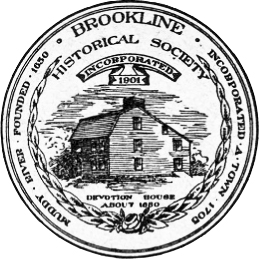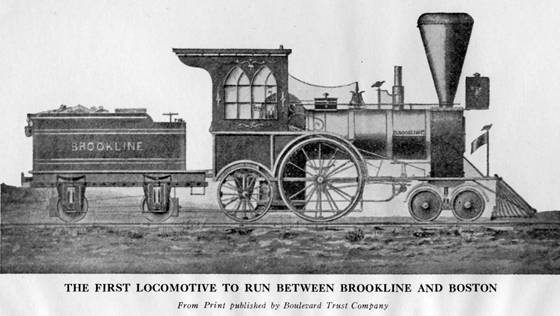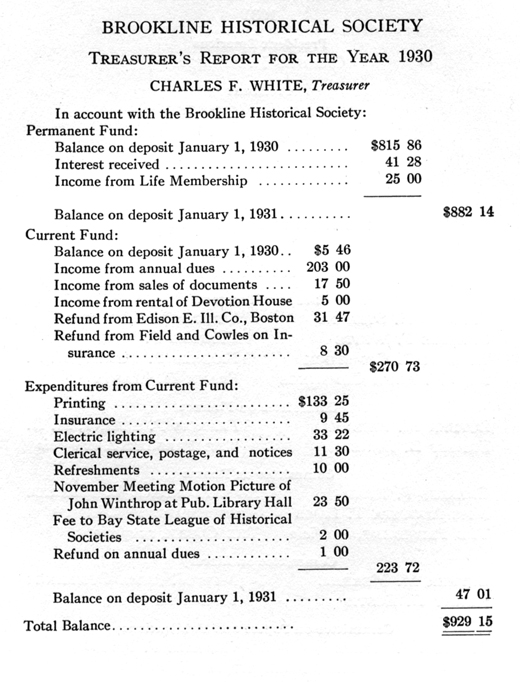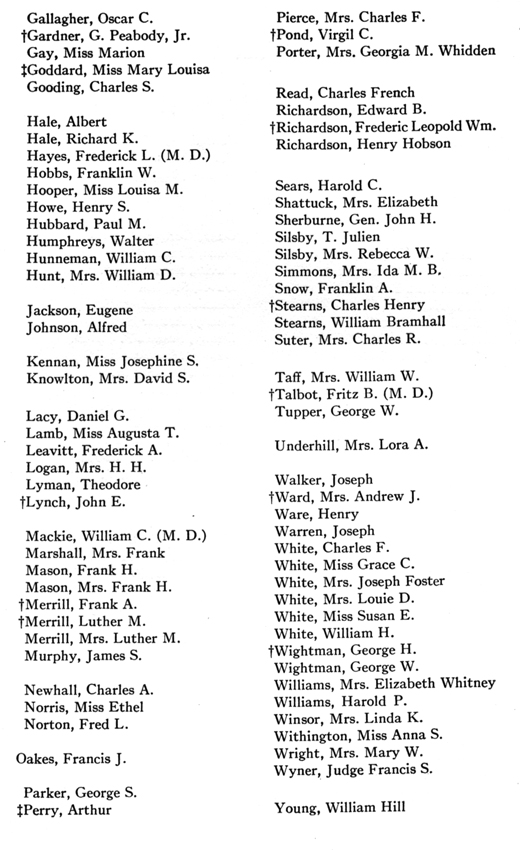
PROCEEDINGS
OF THE
BROOKLINE HISTORICAL SOCIETY
AT THE
ANNUAL MEETING, JANUARY 29, 1931
BROOKLINE, MASS.
PUBLISHED BY THE SOCIETY
MCMXXXI
Committee on Papers and Publications.
OF THE
BROOKLINE HISTORICAL SOCIETY
AT THE
ANNUAL MEETING, JANUARY 29, 1931
BROOKLINE, MASS.
PUBLISHED BY THE SOCIETY
MCMXXXI
Committee on Papers and Publications.
Charles F. White.
Charles F. Read.
The President, ex officio
Charles F. Read.
The President, ex officio
Contents:
- Address of the President
- Brookline's First Locomotive
- Report of the Treasurer
- Officers and Committees
- List of Members
BROOKLINE HISTORICAL SOCIETY
THIRTIETH ANNUAL MEETING.
January 29, 1931
THIRTIETH ANNUAL MEETING.
January 29, 1931
The twenty-ninth annual meeting of the Brookline Historical Society was held in the Edward Devotion House, Brookline, on January 29, 1931, at 8 p. m., Vice-President Francis P. Denny, M.D., in the chair.
Members of the Brookline Historical Society and Friends: -
It is with great pleasure that I welcome you to this Annual Meeting of our Society. Our membership is as follows:
Annual members: 115
Life members: 24
Benefactors: 3
Total: 142
Life members: 24
Benefactors: 3
Total: 142
We welcome the new members of 1930. They are as follows: They are as follows: Theodore Lyman, Judge Francis S. Wyner, Miss Ethel Norris, and Mrs. Wallace O. Fenn.
The following eight members have died:
Miss Mary A. White, died May 7,1930.
Miss Helen Turner, died July 6,1930.
John B. Westbrook, died July 14, 1930.
Arthur F. Clarke, died July 27, 1930.
William D. Hunt, died August 22,1930.
Mrs. Joseph H. White, died October 29,1930.
Frederick P. Fish, died November 6, 1930.
William F. Crafts, died December 26,1930.
Miss Helen Turner, died July 6,1930.
John B. Westbrook, died July 14, 1930.
Arthur F. Clarke, died July 27, 1930.
William D. Hunt, died August 22,1930.
Mrs. Joseph H. White, died October 29,1930.
Frederick P. Fish, died November 6, 1930.
William F. Crafts, died December 26,1930.
This report can record but an inadequate word in regard to each of these members who have passed and whose loss we feel greatly. Miss Mary A. White was a member of a family living for many years on Tappan Street. She was a teacher of English Literature in a private school and a devoted member of the Harvard Church, noted for her kindness and good works.
Miss Helen Turner was an old-time resident, living as a child on Linden Place and later owning a house on Beacon Street near the Hotel Beaconsfield. Many years ago her father was an Assessor of Brookline.
Mr. John B. Westbrook was a retired contractor living in a beautiful home on Clinton Road, Brookline.
Mr. Arthur F. Clarke had retired from business and had been for many years a member of the American Society of Civil Engineers. He lived on Osborn Road and was a relative of our trustee, Mr. Charles F. Read. He often came to meetings of The Bostonian Society as well as to the Brookline Historical Society meetings.
Mr. William D. Hunt was a retired Boston merchant and had lived for many years with his family on Warren Street near Boylston. He was very fond of sports and in the era of horses was devotedly interested in them and in driving. He was a member of the First Parish Church.
Mrs. Joseph H. White died in her ninety-fifth year at the Hotel Somerset in Boston. She was the widow of the late Joseph H. White and they and their family lived for many years in the beautiful estate on Boylston Street opposite the old Brookline Reservoir. A beautiful tribute to her was printed in the Brookline Chronicle of November 6, 1930, reprinted from the Boston Transcript.
Mr. Frederick P. Fish, a noted lawyer, was a former president of the American Telephone and Telegraph Company and greatly interested in Brookline affairs.
Mr. William F. Crafts was born in Roxbury, August 24, 1855, but for many years lived in Brookline. His ancestors owned land in the southern part of the town. Mr. Crafts was much interested in our society and loaned some furniture placed in the Edward Devotion House when the society first had the use of the building. He and Mr. James M. Crafts compiled and published in 1893 the great work about the descendants of Griffin and Alice Crafts of Roxbury, Massachusetts, an octavo genealogy of eight hundred pages.
During 1930 the society held four meetings. Three regular and one tercentenary meeting. The meetings at the Edward Devotion House were in January, March, and May, and the meeting commemorating the three hundredth year of Massachusetts Bay settlement and the two hundred and twenty-fifth year of Brookline as a separate town was held on Brookline Day in November in the hall of the Brookline Public Library.
The Annual Meeting was on January 30 at 8.00 p. m. In the absence of the President, Vice-President Charles F. Read presided. W. Ogilvie Comstock, Jr., was appointed Clerk pro tem. The minutes of the last meeting were read and approved. The President's address was read by Mr. Read. Treasurer Charles F. White read his report which was accepted and voted to be published as usual. Mr. J. Francis Driscoll reported for the nominating committee and the officers were elected for the following year.
Mr. Read spoke of the coming to Boston soon of the Mayor of Boston, England. Mr. Driscoll spoke of marking points of interest in Brookline for the benefit of tercentenary visitors. A committee on marking these sites was appointed as follows: Mr. Charles F. White, Chairman, and Mr. Charles H. Stearns, Miss Louisa M. Hooper, Mr. Luther M. Merrill, Mr. J. Francis Driscoll, and the President ex-officio.
The March meeting was held on Wednesday, March 26, at eight o'clock, the President presiding. Mrs. Wallace O. Fenn was elected a life member. The President spoke of patriotic exercises to be held on the Weld Estate by children of the D. A. R. in June. He stated that Mr. Charles F. White had been appointed, by the Selectmen, Chairman of the Tercentenary Committee for Brookline. At a previous Trustees' meeting Dr. Francis P. Denny was elected Vice-President of the Society, Mr. Charles F. Read having resigned.
The paper of the evening was by Dr. Carleton S. Francis, entitled "Walks and Talks about Brookline." This was a paper of old times and was valuable, interesting, and amusing. It was printed in our last report and enjoyed by those who could not hear it. At the close of the reading of the paper other members related stories of the old days. An old water color drawing belonging to the Society made by Frank Rogers, a graduate of the Brookline High School, of the first locomotive running into Brookline on the Boston and Worcester Railroad was voted to- be framed and hung in the Public Library. This has been done by Miss Hooper. The engine was named Brookline and the picture can be seen at the Library. This early engine, built in Liverpool in 1835, was imported for the Boston and Worcester Railroad and used for many years. It was sold by the road, the name changed to Farmingdale, in 1870, by the Portland and Kennebec Railroad, and lost in a collision near Gardner, Maine, in 1874.
On the evening of May 28 a regular meeting of the Society was held at the Devotion House, your president presiding. The records were read and Miss Hooper expressed appreciation and thanks from the Library for the water color drawing of the locomotive Brookline. A letter was read regarding the construction of the Port Royal House in Nova Scotia. The President spoke of the celebrations at Andover and Dorchester. In the absence of Representative Rev. Charles L. Page, his friend, Dr. Charles J. Douglas came from Roxbury and addressed the society. He gave us a most interesting description of English cities and towns after which our towns were named, such as Boston, Worcester, Winchester, and others. He spoke of tercentenary celebrations here with great interest and was voted hearty thanks by the society. In the vote was included thanks to Rev. Charles L. Page for kindly supplying a speaker for the evening.
The Thursday, November 13, "Brookline Day" meeting at the Public Library Hall was at 8.00 o'clock and Vice-President Dr. Francis P. Denny presided. The hall was filled and all enjoyed the tercentenary three reel Yale film picture of "The First Settlers of the Massachusetts Bay Colony." The society felt glad that so many could see this accurate and therefore very instructive picture of the early days of this colony. The many young people that were there will long remember the early history from this and the pictures shown a few years ago at the High School by the American Heroes' Day Committee.
Much interest has been shown in the wording and placing of tercentenary signs and the accounts given in the Brookline Chronicle of early Brookline and much is owed to the Brookline Tercentenary Committee, but especially to its Chairman, Mr. Charles F. White, for the work they have done.
In reviewing Brookline in the tercentenary year, comment should be made of work done at the Public Library, in the schools and churches, and by Brookline people in helping not only here but in the celebrations in Boston and other places. The procession in Brookline was the most spectacular event. The town has been continuing its upbuilding and has given great employment to many by road improvement. The new golf grounds are taking on a look of civilization, being well cleared and drained, adding value to all that part of the town; the new state road helping very much there also.
The Bay State Historical League had its four meetings this year and much help and enjoyment was given to those interested in history.
The winter meeting of the League was on January 25 in Wilder Hall, 9 Ashburton Place, Boston, at 2.00 p. m., and the subject was, "What Unmarked Historical Sites are there in your Locality?"
The spring meeting was in Lynn on April 26 in the rooms of the Lynn Historical Society, the subject being "Are Your Historical Collections Fully Available to the Public?" The new annex containing their collection was viewed with interest.
The Annual Meeting was at Marblehead on June 21 in the historic Lee Mansion.
The fall meeting was in the Otis House, corner of Lynde and Cambridge streets, Boston, the home of the Society for the Preservation of New England Antiquities, on November 1, the subject discussed was "The Tercentenary Activities."
The Edward Devotion House was open as usual on the 19th of April and your president and other members of the Society helped to entertain the rider, representing Lieutenant William Dawes, Jr., and his escort on their way to Lexington. The Chronicle gave an account of the ceremonies.
Not only on January 1st, 1930, was the bell of the First Parish Church rung at noon as stated in our last report, but it was rung at noon for five minutes on March 4, 1930, in commemoration of the signing of the Massachusetts Bay Charter in 1629.
In the Brookline Chronicle of September 25th last there was printed a sketch map of Brookline made by Mr. Charles F. White showing the locations of twenty places of historical interest in the Town, marked by the Town Committee, of which Mr. White was Chairman and our member Mr. Francis J. Driscoll was the other most active worker.
Only two houses were marked by the State Committee as having stood about as now before 1750. This Edward Devotion House was before 1700 and the Dr. Zabdiel Boylston house built before 1750 and after 1855 called the Lee House. Interior woodwork of Dr. and Mrs. George H. Wright's house on Goddard Avenue was in use the history says in 1667 and incorporated in the present house in 1767. A bronze tablet on a large boulder has been placed near the front of the house. The Miss Julia Goddard House on Warren Street, marked 1730, was not marked by the State but by the Town. A bronze tablet has been placed on the front of Pierce Hall, Walnut Street, now a part of the church building of the First Parish. In its original shape it was the first Town Hall and then the first High School.
Signs giving the former names of some of Brookline's streets were carefully painted by Mr. W. R. Pazolt. The wording. and locations were decided on by Mr. John Gardner Coolidge and by our fellow-member, Mr. Daniel G. Lacy as head of the Highway Department. They attract interest and look well, so that, with this work and the work done by the Chronicle and the Library, much early history has been recorded, and we hope our printed history of Brookline is soon to come.
We regret that our former Vice-President, Mr. Charles F. Read, felt that he could not continue in the office, but he is still a Trustee, as active as ever. We welcome our new Vice-President, Dr. Francis P. Denny, and the thanks of the Society are especially due to him for his work on the Edward W. Baker Memorial History of Brookline.
WILLIAM O. COMSTOCK.
Brookline, January 29, 1931.

By Charles F. White
The placing of a picture of the Locomotive in the delivery room of the Public Library this tercentenary year has created considerable interest in this early engine. This water colored drawing is the only original picture of it, so far as the writer knows. Without this drawing, presented by the artist to the Brookline Historical Society several years ago, we should have no representation of a type of locomotive seldom seen in America though quite common in England in its day.
Frank Kimball Rogers, son of John Kimball and Sarah (Niles) Rogers, was born in November, 1854, and died in Providence, Rhode Island, in November, 1930. The family lived on Kent Street, near Colchester Street. There were two sisters, Susan and Sarah. Frank Rogers entered the Brookline High School in the autumn of 1868 and left it in 1871, not finishing the course by one year. His interests lay in drawing and in machinery and he became a trained draftsman. About 1876 he went to Providence where he lived the remainder of his life. He was never married.
In 1911 Mr. James E. Alger, a former Brookline boy, but long resident of Reading, Massachusetts, wrote four articles on Old Brookline as he knew it, which were published in the Chronicle of June 3d and 17th, October 21st, and December 30th of 1911. Beside many references to people and events there was much detail as to the "Lion-Brookline" of which his father, James M. Alger, was the engine-man. Reference can be had to these issues. Records of the engines of the Boston and Worcester (B. & A.) Railroad show their first one to be English, a "four wheeler" by Robert Stephenson of the Darlington Works named the "Boston," bought in 1832. The next was the "Yankee" by the Mill Dam Foundry Co. in the Back Bay, 1834. The third was from Stephenson the "Meteor" also of 1834 which in many respects was like the "Lion," but unlike the "Lion" had no "trailing wheels." These four-wheeled short engines had a tendency to pitch on imperfect track and the "Lion's" trailing wheels giving a longer wheel-base prevented this and provided steady running at all speeds. The "Lion," built by the Bury Works of Liverpool, was very fast if speed was wanted. The writer, when a boy in the Pierce Grammar School, often examined this -unusual engine which for several years was on "dead storage" in one of the three Brookline car-houses at Station Street. I ts most peculiar feature was in the driving and trailing wheels (original) which had round iron spokes about an inch thick welded into the wrought iron hubs and rivetted to the wheel rims, as the picture shows. These spokes were staggered like cycle-spokes to stiffen the wheel. Tyres were shrunk onto the wheel-centres. After six years' use for the Brookline Branch Railroad, the "Lion" was-rebuilt and came out with cab, big wood-burner, smoke-stack, lantern, bell, cowcatcher, and a John B. Jervis bogie-truck of four cast-iron wheels, as seen in the drawing, and its new name, "Brookline." After serving in building the New York and Boston Air-Line Railroad from Needham to Brookline, during which time it acquired the name of "Z. E. Coffin," it was sold to the Portland and Kennebec Railroad of Maine and came to its end in a head-on collision near Gardiner, then renamed the "Farmington." Many of the most famous English engines -were like the "Lion" and one of these, the "North Star" from the Great Western Railway, one of the seven-foot gauge with seven-foot drives, was in the Baltimore "Fair of the Iron Horse" in 1927.



